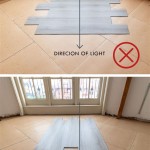Installing Luxury Vinyl Plank Flooring Over Tile: A Guide
Luxury vinyl plank (LVP) flooring has gained immense popularity due to its durability, water resistance, and aesthetically pleasing appearance. It can seamlessly mimic the look of natural wood, stone, or even concrete, offering a wide array of design options to suit any home decor. For homeowners looking to refresh their existing tile floors without the hassle of complete removal, installing LVP over tile presents a viable solution.
While the process may appear straightforward, it's crucial to understand the considerations and steps involved to ensure a successful and long-lasting installation. This article will provide a comprehensive guide to installing LVP over tile, addressing key aspects like preparation, materials, and installation techniques.
Preparing the Tile Subfloor
The foundation for a successful LVP installation lies in a properly prepared subfloor. Tile floors, while sturdy, can pose unique challenges due to their uneven surface and potential for grout lines. It's essential to address these factors to create a smooth and level base for the LVP planks:
-
Check for Levelness:
Use a level to assess the flatness of the tile surface. Any significant dips or bumps exceeding 1/8 inch within a 10-foot span require leveling with thinset mortar or self-leveling compound. -
Inspect Grout Lines:
Wide or uneven grout lines can interfere with the installation and cause uneven flooring. Consider grinding down prominent grout lines or filling them with a compatible sealant. -
Clean the Surface:
Thoroughly clean the tile surface to remove dirt, grease, and debris. This ensures proper adhesion of the underlayment and LVP planks.
Choosing the Right Underlayment
Underlayment serves as a crucial buffer between the subfloor and LVP planks, offering several benefits:
-
Sound Reduction:
Underlayment effectively dampens sound, minimizing noise transmission between floors. -
Impact Absorption:
It cushions foot traffic, reducing the risk of LVP planks cracking or becoming damaged. -
Moisture Protection:
Some underlayment options offer a moisture barrier, providing an additional layer of protection against water damage.
When selecting underlayment for LVP installation over tile, consider these factors:
-
Thickness:
Opt for a thicker underlayment (at least 3/16 inch) to provide adequate cushioning and level out minor imperfections. -
Density:
Choose an underlayment with a high density to ensure durability and support. -
Moisture Resistance:
For areas prone to moisture, select a moisture-resistant underlayment.
Installing the LVP Flooring
Once the subfloor is prepared and the underlayment is laid, the LVP installation begins. The specific process may vary depending on the LVP type and manufacturer instructions. However, the general steps involve:
-
Start at the Wall:
Begin laying planks in the furthest corner of the room, working your way towards the entrance. Leave a small expansion gap between the planks and walls to allow for movement. -
Click-Lock System:
Many LVP planks feature a click-lock system for easy installation. Simply align the edges, press down, and click the planks together. -
Stagger the Seams:
Avoid placing planks directly next to each other. Stagger the seams for a more aesthetically pleasing and structurally sound installation. -
Cut Planks to Fit:
Use a sharp utility knife or specialized flooring saw to trim planks to fit around corners and edges. -
Secure the Perimeter:
Use transition strips or moldings to cover expansion gaps and create a seamless transition to other flooring types.
Essential Considerations
Installing LVP over tile requires careful planning and attention to detail. Here are some crucial considerations:
-
Acclimation:
Allow the LVP planks to acclimate to the room temperature for at least 48 hours before installation. This helps prevent warping or expansion. -
Manufacturer Instructions:
Always consult the manufacturer's instructions for specific recommendations and warranty information. -
Professional Installation:
If you lack experience with flooring installation, consider hiring a professional installer.
In conclusion, installing LVP over tile can provide a stylish and cost-effective way to upgrade your existing floors. By following the guidelines and tips outlined in this article, you can ensure a successful and durable installation that will enhance the beauty and functionality of your home.

New Vinyl Plank Flooring Over Tile Table And Hearth

New Vinyl Plank Flooring Over Tile Table And Hearth

New Vinyl Plank Flooring Over Tile Table And Hearth

How To Install Vinyl Plank Flooring As A Beginner Home Renovation

New Vinyl Plank Flooring Over Tile Table And Hearth

How To Install Vinyl Plank Flooring As A Beginner Home Renovation

New Vinyl Plank Flooring Over Tile Table And Hearth

Can You Install Vinyl Plank Over Tile Flooring America

Can You Lay Hybrid Flooring Over Tiles The Guys

Can Vinyl Flooring Be Laid Over Laminate Go For Floors
Related Posts








